The Sagrada Familia
The Expiatory Temple of the Sagrada Familia, also known simply as the Basilica of the Sagrada Familia, and popularly as Sagrada Familia, is an enormous Catholic church in the city of Barcelona, Catalonia, Spain.

As a curiosity, the name "Expiatory Temple" given to the Sagrada Família is because it was built with donations and fundraising through ticket sales. Its official status as a Basilica was granted by Pope Benedict XVI in 2010, making it a church of great importance.
The Sagrada Família was designed by the Catalan architect Antoni Gaudí, and is considered by many critics to be his masterpiece and an exponent of Catalan modernist architecture. Financed solely by private contributions, construction began in 1882 and was taken over by Gaudí in 1883, when he was 31 years old, dedicating the last 40 years of his life to the project, and the last fifteen exclusively.

Regarding the stained-glass windows of the Sagrada Família, their history is as fascinating as the Basilica itself. They are not merely decorative elements, but an essential part of Antoni Gaudí's spiritual and architectural vision, who stated that "sunshine is the best painter." He saw light as a divine and fundamental element in creating an atmosphere of transcendence within the temple. Therefore, he designed a structure that allows abundant light to enter.

Joan Vila i Grau, a renowned Catalan glassmaker, designed the stained glass windows, following Gaudí's principles to create a marvel of color and spirituality.

The color of the stained glass windows varies according to the sun. Stained glass windows facing east and south have warm tones (red, orange, yellow), while those facing west and north have cool tones (blue, green, violet). This creates different atmospheres throughout the day.
Let's build the stained glass windows of the Sagrada Família, with their colors and tones, in the game Sagrada!
Sagrada - Game Info
Sagrada is a 2-to-4 players game, age 14+, by designers Adrian Adamescu and Daryl Andrews. Art by Peter Wocken.
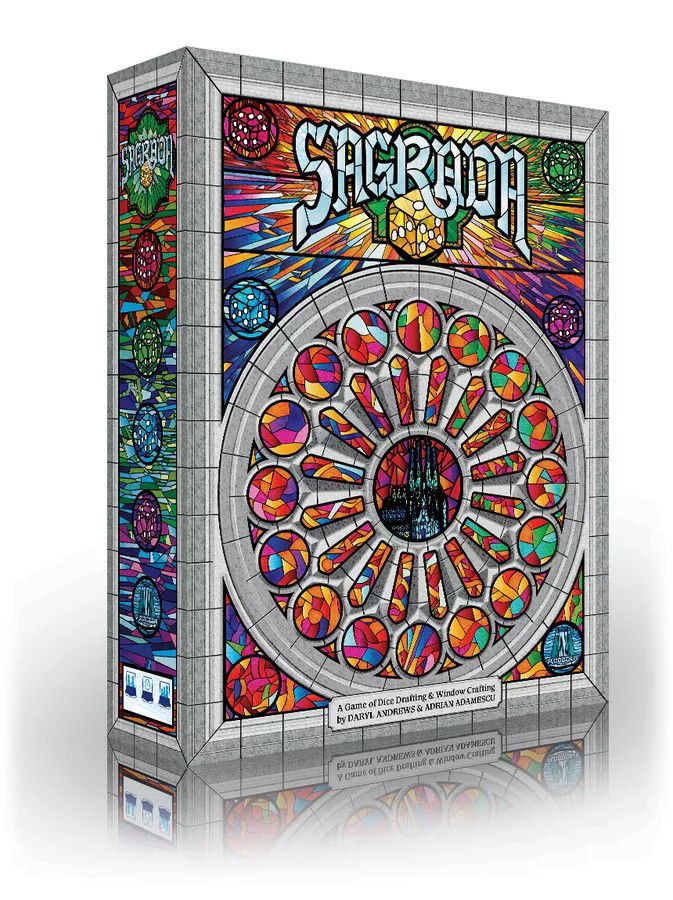
Sagrada was released in 2017 by Floodgate Games. Its mechanics include collecting sets, model-based building, and dice rolling.
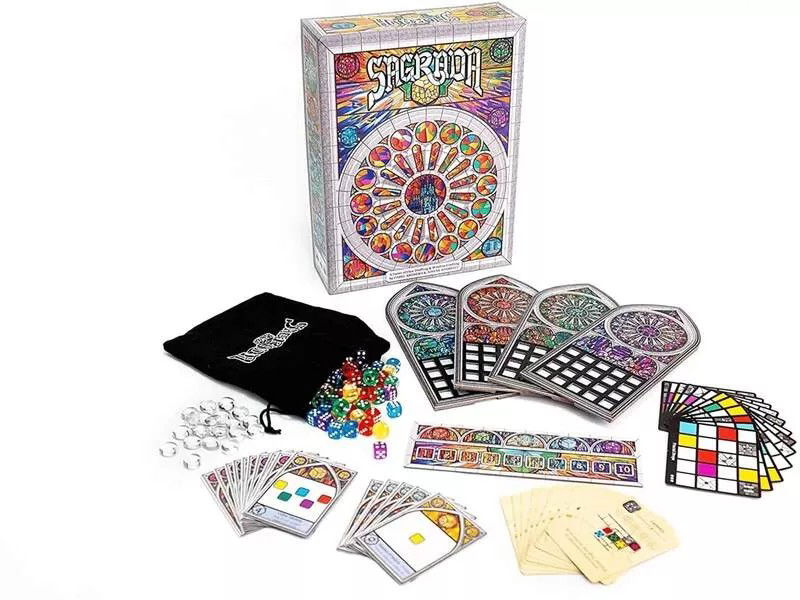
Sagrada has stood out since its release. Here are some accolades:
- In 2017, it was nominated in the categories Best Art, Best Family Game, Best Solo Game, Game of the Year, and Innovative Game, all by Golden Geek;
- In 2018, it was a finalist for Game of the Year by JUGuinho Families, and nominated for Best Game and Best Family Game by Origins Awards;
- In 2019, it was nominated for Game of the Year by GEEKS d'OURO and for Family Game of the Year by Gra Roku;
- In 2022, it was nominated for Best Adult Game by Årets Spel and for Best Family Game by Guldbrikken.
Let's play!
Playing the Game
You are an artist competing with fellow craftsmen to create the most beautiful stained-glass window for the Sagrada Familia. Each round will be a fierce battle for the glass pieces, and the available options won't always meet your expectations. Therefore, use your advantages and choose the right tool to complete your masterpiece on time. Who will be the best and most efficient artisan?
This is the setting of Sagrada!
As a stained-glass artisan, you will have a window frame (your individual game board) at your disposal to assemble the stained glass according to the proposed model. Each model has requirements and restrictions, as well as a difficulty level. This level is important because, based on it, you receive favor tokens that can be used to access tools.
All of this takes place amidst a competition for the glass available in each round. The glass, represented by translucent dice, has two characteristics: color and shade (value). Lower values represent lighter shades, and higher values, darker shades. In addition, you will have personal and public objectives to fulfill to increase your score. The game lasts only 10 rounds, so any mistakes or blank spaces can be costly.
In the setup, each player receives a window frame and two double-sided window pattern cards. Thus, each participant has four model options to choose from and define how their assembly will be.
This choice is crucial, as each model has a difficulty level, and it is based on this level that the favor tokens will be distributed, which can be used to activate tools or, if there are any left over, yield victory points at the end of the game.
Shuffle the private objective cards, deal one to each player, and shuffle the tool and public objective cards. Reveal three of each in the center of the table. Place the round track board in the center, distribute the scoring token to each player, and place the 90 dice in the bag.
That's it! Now, let's understand how a turn goes, which begins clockwise:
- Phase 1: take dice from the bag;
- Phase 2 (optional): select dice and/or use a tool card.
After the last player completes or skips Phase 2, the round continues counter-clockwise:
- Phase 3 (optional): select dice and/or use a tool card. In Phase 1, the first player must draw dice from the bag. For each player, 2 dice are draw + 1 extra. For example, with 4 players, you draw 9 dice.
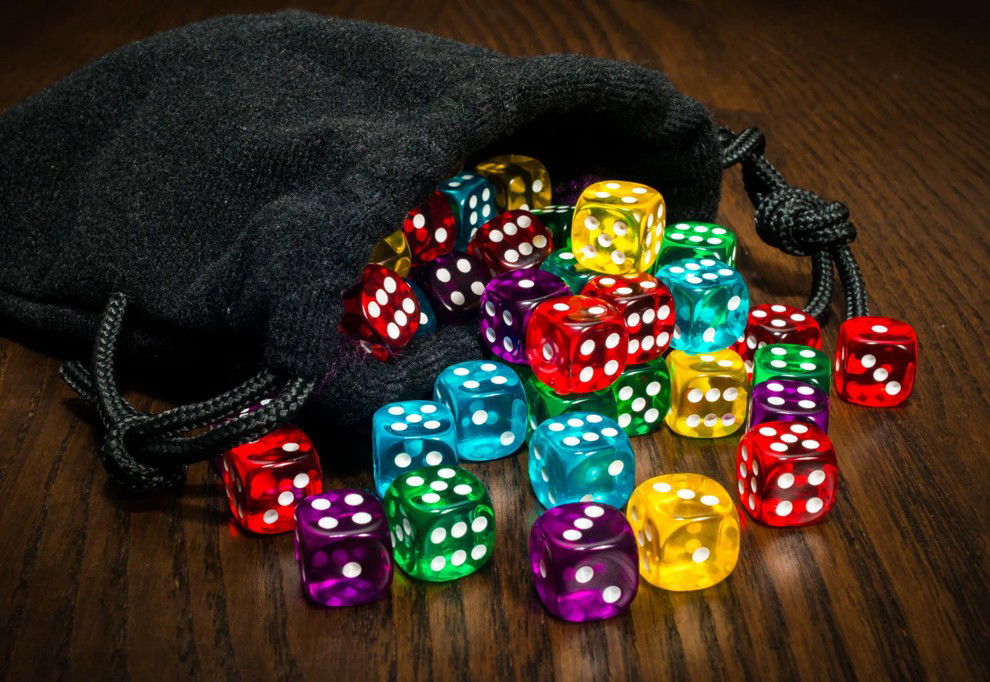
Place these dice in the center of the table to form a draft pool; they represent the glassware that can be used. Remember that the dice have a color and a shade (their value).

Phase 2 and Phase 3 have the same options, and are optional. The difference is that Phase 2 occurs in a clockwise direction and Phase 3 in a counter-clockwise direction. Both allow you to:
- select a die from the pool; AND/OR
- use a tool card.
When selecting a die, consider the color and tone to place it in its frame, respecting the rules of stained glass:
- the die must match the color or tone required by the location;
- the first die in each frame must be placed next to the edge or in a corner;
- all dies must be placed adjacent, orthogonally or diagonally, to a die already inserted;
- dice of the same color or tone can never be placed orthogonally adjacent.
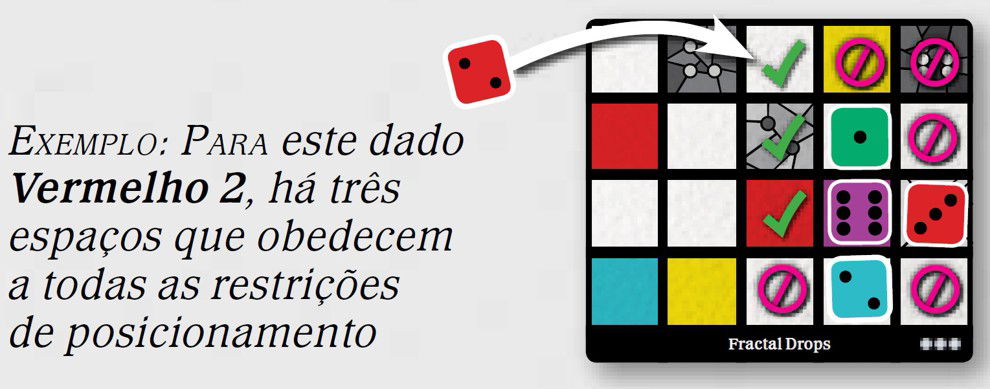
You can also pay to use a tool, which allows you to break specific rules, thus gaining a benefit.
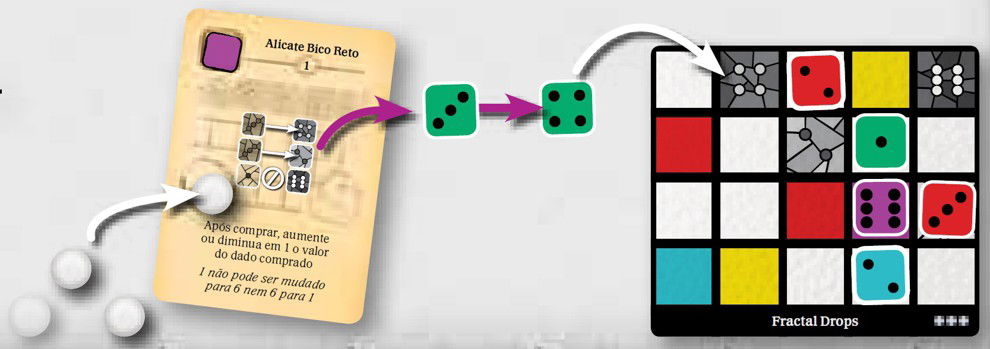
Each tool costs one token to the first player to use that tool. The next player will cost 2 tokens, and so on.
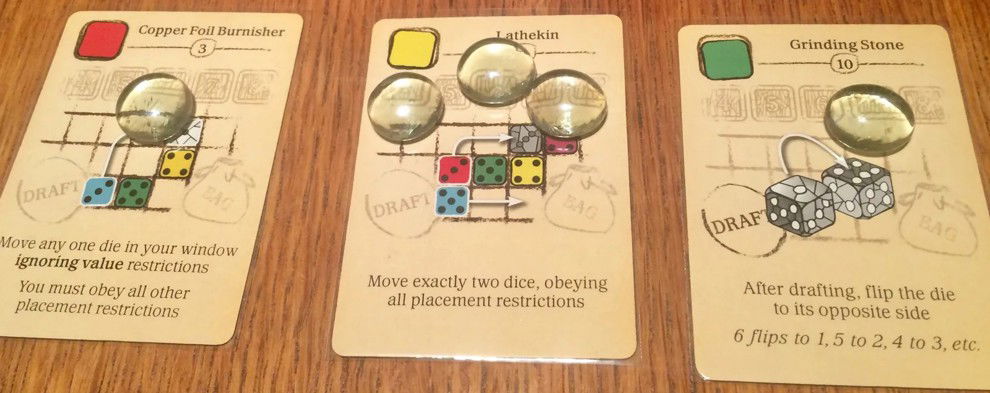
After reaching the last player, it's time to execute Phase 3, which is the same as Phase 2, except it's done counter-clockwise.
At the end of the round, one or more dice will remain; they must be placed on the round track board in the center of the table.

After the last action, the remaining dice go onto the round board, indicating the current round and how much time is left until the end of the game.
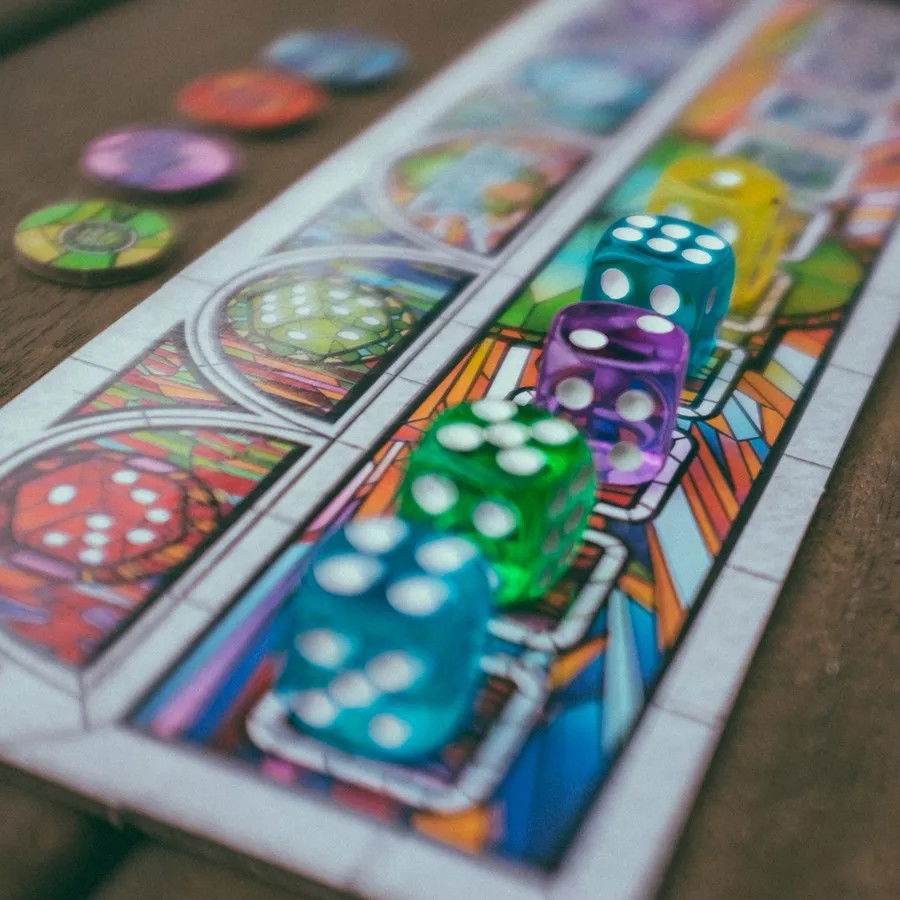
The player on the left takes the starting position for the next round.
That's a round of Sagrada!
Ending the Game
The game ends after the 10th round.
It is suggested to remove the dice from the round track board and turn it over, as the scoring track is on the other side. Use each player's scoring token to mark their points on the scoring track, flipping the token if their scores exceed 50 points.
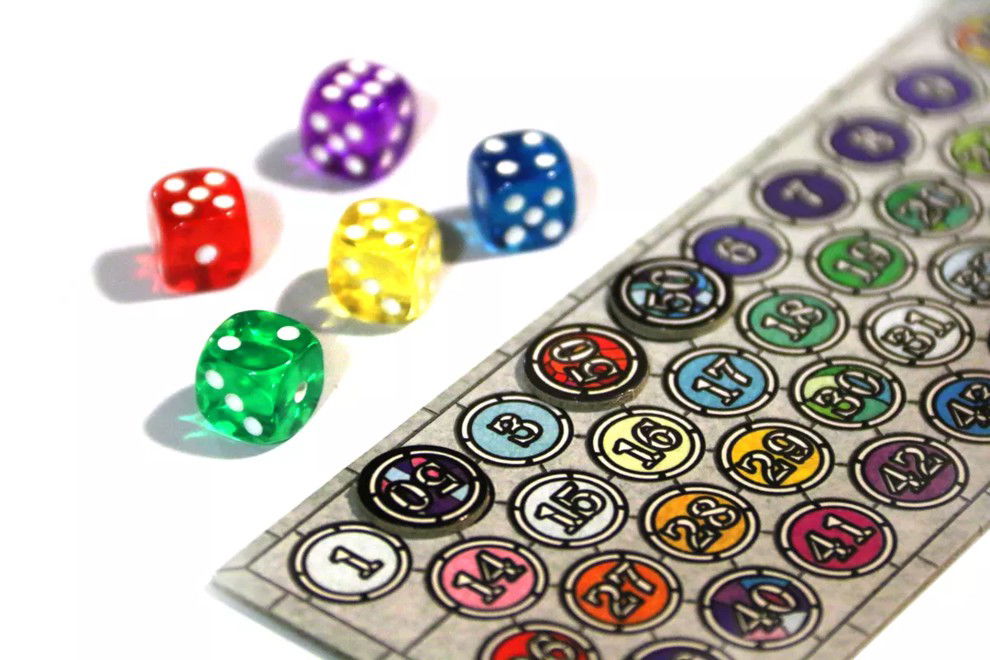
The total victory points for each player are calculated as follows:
- public objective card: players can earn points from each card multiple times;
- row/column-based objectives only count if they are complete (no empty spaces);
- your personal objective card: the values of your dice of the indicated color are added;
- favor tokens: 1 victory point for each unspent marker;
- lose 1 victory point for each empty space in your windows.
The player with the highest total victory points is the winner.
Ties are resolved by observing who has more personal objective points, more remaining benefit markers, and finally, by reverse order of players during the last round.
Strategy Tips
Sagrada is highly strategic. It's necessary to observe the colors and tones (values) of the dice and link this information to your stained-glass model, and, obviously, to those of your opponents as well, since you may need the same die. Think ahead on your plays, and on your opponents' as well!
Phase 1 has no deep strategy involved, and no way to circumvent it. Just take the correct number of dice and place them in the center. That's pretty much all there's to it.
Phase 2, both clockwise and counter-clockwise, has the same tips:
- look at your stained-glass model and see which dice meet the color and tone (value) requirements;
- note if the desired die also meets the opponents' requirements. If so, I strongly recommend taking it without hesitation;
- if no opponent can use the die you're interested in, take another one and save that one for Phase 3.
Now, something that unfortunately “almost always” happens: errors in dice placement.
At any time, if a player notices errors in the placement of the dice in their window frame or another player's (disregarding the stained-glass window design, or violating any placement restrictions), the player responsible for the stained-glass window must immediately remove the dice (at their choice) until all restrictions are met.
These removed dice will be out of the game, and any resulting free spaces will be counted in the end-game score.
Regarding the use of tools: if you wish to use them, don't hesitate, use them, since they become more expensive as time goes by. Your opponents may use them just to increase the cost of the tool for other players, which is a valid strategic move. However, make sure you are the one to do it first. In any case, if you don't strategically need them, I recommend not using them, as the tokens guarantee points at the end of the game.
Another important tip that almost everyone forgets: pay attention to your private objective and the public objectives. They provide extra points. Many players forget this, as they become so focused on choosing the dice and the restrictions of their stained glass model that they neglect these objectives. Don't make this mistake, it's really important and can be the difference between victory and defeat.
Based on these tips, develop your best strategy, carefully choose the color and shade (value) of the die for your stained glass, and win at Sagrada.
Unboxing, Rules, and Gameplay Videos
Unboxing:
Rules:
Gameplay:
Pedagogical Tips
If you're looking for a game that will delight children, and also easy to teach and learn, Sagrada is the perfect game. Furthermore, it exercises important skills in children while they have fun.
Sagrada teaches colors. Take advantage of this, as the game has 5 different colors: red, yellow, green, blue, and purple. Use it to reinforce the names of the colors in a playful and practical way. In addition, logical-mathematical reasoning will be constantly used, since the values of the dice represent the shades of the colors. The number 1 is the weakest shade, and the higher the number, the stronger the shade of the color.
During the game, the values of the dice will also be required at other times: when positioning them in the window frame and when using the benefit markers to activate tools. This explores another important concept: resource management. Children will learn to manage the number of their markers to determine if they can pay for the use of tools, as well as keep them as victory points at the end of the game.
By positioning the dice in the window frame, children will also work on spatial orientation with the concepts of orthogonal and diagonal adjacency.
Pedagogically, Sagrada teaches resource management, stimulates strategy, decision-making, logical-mathematical reasoning, spatial orientation and, above all, is fun!
I highly recommend Sagrada for your collection!








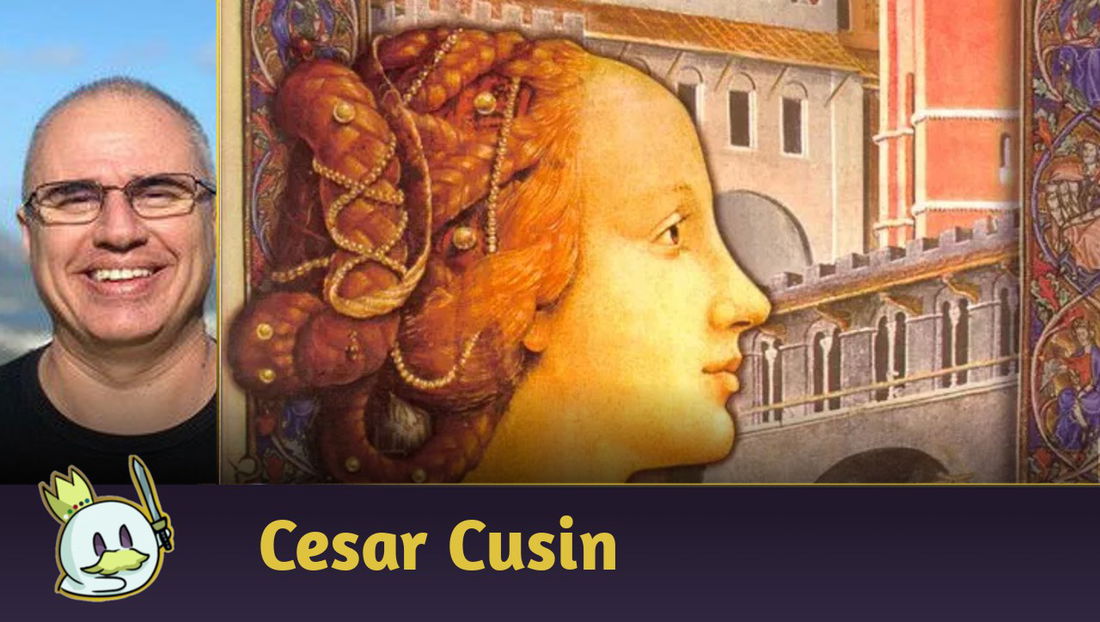



— تعليقات 0
, ردود الفعل 1
كن أول من يعلق